by Heather Kent | Apr 17, 2024
 Who doesn’t love a warm, soft pretzel? Did you know they are fast and easy to make? Pretzels are a yummy way to introduce youth to the science of bread baking. Following a recipe can also help them practice following directions and measuring ingredients. Plus….it’s just fun! In honor of National Pretzel Day, we are sharing our tried and true soft pretzel recipe, which is perfect for your next 4-H club meeting or a fun family night. Of course, be sure to note any youth with food allergies and plan accordingly! This recipe makes 12 pretzels, so you may need to double (or triple) the recipe depending on the number of people you have.
Who doesn’t love a warm, soft pretzel? Did you know they are fast and easy to make? Pretzels are a yummy way to introduce youth to the science of bread baking. Following a recipe can also help them practice following directions and measuring ingredients. Plus….it’s just fun! In honor of National Pretzel Day, we are sharing our tried and true soft pretzel recipe, which is perfect for your next 4-H club meeting or a fun family night. Of course, be sure to note any youth with food allergies and plan accordingly! This recipe makes 12 pretzels, so you may need to double (or triple) the recipe depending on the number of people you have.
You can demonstrate making the dough, or divide youth up into groups of 4-5 to make a recipe of dough each. In addition to the ingredients below, you will need either a stand mixer or a bowl and spoon for each group, measuring spoons, a liquid 1-cup measuring cup, 1-cup measure for solids, baking sheets, parchment paper, pastry brush, oven, and pot-holders.
Tips for baking with youth:
- Create stations with all the supplies (including the recipe) needed. If possible, have a teen or adult for each station.
- Demonstrate how to measure ingredients
- Demonstrate how to knead and shape the dough
Ingredients:
This is optional, but you can have a variety of toppings for youth to try:
- Traditional-course sea salt
- Cheesy- nutritional yeast (if allergic to dairy), or cheese-flavored seasonings (like the kind you use for popcorn)
- Ranch, or any other seasoning you prefer
Instructions:
- Stir the yeast into warm water and sugar (or honey). Allow to sit for 1 minute. Slowly add 3 cups of flour, 1 cup at a time. Mix with a wooden spoon (or dough hook attached to stand mixer) until dough is thick. Add 3/4 cup more flour until the dough is no longer sticky. If the dough is sticky, continue to add flour (a small bit at the time) until it is no longer sticky. This will depend on how much humidity is in the air (this is a great science discussion!).
- If using a stand mixer, keep the dough in the mixer and beat for an additional 5 full minutes. If mixing by hand, place the dough on a lightly floured surface and knead with clean hands for 5 full minutes. If the dough becomes too sticky during the kneading process, sprinkle more flour on the dough as needed. After kneading, the dough should slowly bounces back when you poke it with your finger.
- Shape the kneaded dough into a ball. Cover lightly with a towel and allow to rest for 10 minutes. While the dough is resting, preheat oven to 400°F (204°C) and line two baking sheets with parchment paper or silicone baking mats.
- After the dough has rested, use a knife to cut it into 12 even portions. Give one portion to each youth, and show them how to roll the dough into a rope, or “snake” shape. Form a circle with the dough bringing the two ends together. Twist the ends and bring them back down over the circle to form the pretzel shape. Place pretzels onto the baking sheets and brush with melted butter and the topping of your choice.
- Bake for 12-15 minutes until golden brown and enjoy!
Further Engagement:
Youth who enjoy this activity may also enjoy the 4-H Breads Project. Youth can enter their baked goods in their local county fair or the North Florida Fair. Youth can also do a demonstration on breadmaking for county events, district events, or 4-H University.
by Heather Kent | Apr 17, 2024
 Gardening is not just about growing plants; it’s about nurturing a connection with the earth, fostering a sense of responsibility, and discovering the wonders of nature. For 4-H youth, gardening provides a hands-on learning experience that teaches valuable skills, promotes healthy living, and instills a lifelong appreciation for the environment. After all, 4-H is about helping youth find their spark! In this article, we’ll explore five engaging activities to help 4-H youth develop their green thumbs and cultivate a love for gardening. These activities are perfect for a club meeting, classroom, or even at home with the family!
Gardening is not just about growing plants; it’s about nurturing a connection with the earth, fostering a sense of responsibility, and discovering the wonders of nature. For 4-H youth, gardening provides a hands-on learning experience that teaches valuable skills, promotes healthy living, and instills a lifelong appreciation for the environment. After all, 4-H is about helping youth find their spark! In this article, we’ll explore five engaging activities to help 4-H youth develop their green thumbs and cultivate a love for gardening. These activities are perfect for a club meeting, classroom, or even at home with the family!
- Recycled Plant Pots– Make plant pots out of recycled materials! This is a fun and easy way to make small pots for seed-starting. All you need are some empty water or juice bottles and newspapers. Download the step-by-step directions.
- Paper Towel Gardening– Figuring out how to space seeds when you plant them can be a daunting task. Seed tapes make this easier, but they are expensive. You can make your own while teaching youth about how many plants can fit in a square foot of space. You will need 2-ply paper towels, school glue, a ruler, and seeds. Most full sheets of paper towels are about 1 foot square. You can do the math to determine how many seeds can fit on one paper towel. Once the spacing is determined, gently pull apart the paper towel layers and use a small amount of glue to glue the seeds in place. Place the other layer of paper toweling over the seeds and glue. Once it dries, you can plant the paper towel according to the depth listed on the seed packet. Below are a few common examples:- Bush Beans- 9 seeds per paper towel
– Cucumbers- 2 seeds per paper towel
– Tomatoes- 1 seed per paper towel
- Plant a Plant Person– in a paper cup, or a recycled plant pot from #1 above, plant grass seed. The pot can be decorated to look like a face with googly eyes!
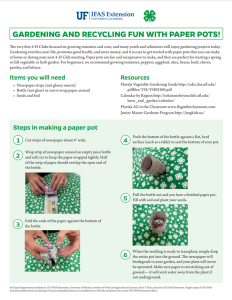 In a few short days, the “plant person” will grow “hair.” The “hair” can be cut with scissors. Step-by-step instructions can be downloaded from Clover by 4-H.
In a few short days, the “plant person” will grow “hair.” The “hair” can be cut with scissors. Step-by-step instructions can be downloaded from Clover by 4-H.
- Planting Party– This activity can double as a service project. Choose a sunny spot at your Extension Office to plant a small herb, vegetable, or flower garden. Work with your Extension office to see if some Master Gardeners might help to demonstrate proper planting techniques, including digging holes, loosening roots, and backfilling with soil. Encourage club members to work together in teams to plant their chosen seedlings, taking turns and offering assistance as needed. Discuss the importance of spacing, watering, and mulching to promote healthy plant growth and prevent competition for resources. As they plant their garden, 4-H youth will develop teamwork skills and a sense of ownership and pride in their collective efforts.
- Garden Journaling: Encourage 4-H youth to keep a garden journal to document their gardening journey and reflect on their experiences. Provide each participant with a notebook or journal and encourage them to record observations, drawings, and notes about their garden activities. Prompt them to write about the plants they’re growing, the weather conditions, any pests or diseases they encounter, and their successes and challenges. Encourage them to take photographs of their garden throughout the growing season to track its progress. Set aside time during club meetings to review and discuss journal entries, share tips and insights, and celebrate achievements. By journaling their experiences, 4-H youth will develop communication skills, critical thinking skills, and a deeper appreciation for the interconnectedness of nature.
Opportunities for further engagement:
If planting seeds and growing them at home, youth can exhibit them at the North Florida Fair in several ways:
- Youth can take photos of their plants and enter it into Class 11. Photos can also be entered in County Events. Blue ribbon photos will move on to 4-H University.
- Youth can enter potted plants or dish gardens in Class 1.
- If harvesting vegetables, youth can enter canned goods in Class 6.
- Youth can create a poster to demonstrate what they learned about gardening (parts of a plant, plant varieties, what plants need to grow, etc). Posters can be entered in Class 12 and can also be entered in County Events. Blue ribbon posters will move on to 4-H University.
- Youth interested in learning more about plants can join a Horticulture Judging Team– the contest takes place on 4-H Day at the Fair on November 9th. The state contest is in June, and the winners go onto the national contest.
Gardening offers endless opportunities for 4-H youth to learn, grow, and connect with the natural world. By engaging in hands-on activities such as seed starting, garden planning, planting parties, journaling, and harvest celebrations, 4-H youth will develop valuable skills, cultivate a love for gardening, and make lasting memories with their peers. So, roll up your sleeves, grab your gardening tools, and let the green thumb adventures begin!
by Heather Kent | Apr 16, 2024
 As the days grow longer and the weather warms up (but isn’t too hot), it’s the perfect time to take your 4-H club activities outdoors! Outdoor activities offer unique opportunities for hands-on learning, team building, and exploration of the natural world. Whether you’re in a rural setting or an urban environment, there are plenty of fun and engaging outdoor activities to enjoy with your 4-H group or as a family. This article shares five ways you can shake things up by taking it outside!
As the days grow longer and the weather warms up (but isn’t too hot), it’s the perfect time to take your 4-H club activities outdoors! Outdoor activities offer unique opportunities for hands-on learning, team building, and exploration of the natural world. Whether you’re in a rural setting or an urban environment, there are plenty of fun and engaging outdoor activities to enjoy with your 4-H group or as a family. This article shares five ways you can shake things up by taking it outside!
Nature Scavenger Hunt: Embark on a nature scavenger hunt to discover the wonders of the great outdoors! Create a list of items for participants to find, such as leaves of different shapes and sizes, animal tracks, bird feathers, or specific types of flowers. Divide the group into teams and set them loose to explore the surrounding area. Encourage participants to use their observation skills and work together to check off items on their list. The team that finds the most items within a designated time wins a prize!
- There is a native plant scavenger hunt as part of the Florida 4-H Bluebird project on page 9 of the Leader’s Guide.
- To make this even more engaging with youth, you can use iNaturalist. It is a free app from National Geographic that uses crowdsourcing to identify plants. You can create your scavenger hunt for your club in the app, and then families or teams of youth use their phone to take a picture, document, and identify plants or animals.
- If youth enjoy this type of activity, you might want to consider the Florida Friendly Landscaping Project or the Florida Youth Naturalist Project. Both projects guide youth through learning about Florida’s native plants and environments.
 Outdoor Games Day: Organize a fun-filled outdoor games day for your 4-H club members to enjoy friendly competition and physical activity. Set up stations for classic games like sack races, tug-of-war, relay races, and frisbee throwing. You can also introduce lesser-known sports or activities such as disc golf, ultimate frisbee, or orienteering. Tailor the games to accommodate different skill levels and abilities, and encourage teamwork, sportsmanship, and fair play among participants. Don’t forget to provide plenty of water, sunscreen, and snacks to keep everyone energized throughout the day!
Outdoor Games Day: Organize a fun-filled outdoor games day for your 4-H club members to enjoy friendly competition and physical activity. Set up stations for classic games like sack races, tug-of-war, relay races, and frisbee throwing. You can also introduce lesser-known sports or activities such as disc golf, ultimate frisbee, or orienteering. Tailor the games to accommodate different skill levels and abilities, and encourage teamwork, sportsmanship, and fair play among participants. Don’t forget to provide plenty of water, sunscreen, and snacks to keep everyone energized throughout the day!
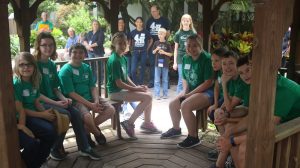 Wildlife Watching: Take a walk on the wild side and explore the fascinating world of local wildlife! Visit nearby parks, nature reserves, or wildlife sanctuaries with your 4-H club and embark on a wildlife-watching adventure. Bring along binoculars, field guides, and notebooks to help identify and record sightings of birds, insects, mammals, reptiles, and amphibians. Encourage participants to observe animal behavior, habitat preferences, and adaptations to their environment.
Wildlife Watching: Take a walk on the wild side and explore the fascinating world of local wildlife! Visit nearby parks, nature reserves, or wildlife sanctuaries with your 4-H club and embark on a wildlife-watching adventure. Bring along binoculars, field guides, and notebooks to help identify and record sightings of birds, insects, mammals, reptiles, and amphibians. Encourage participants to observe animal behavior, habitat preferences, and adaptations to their environment.
- Consider inviting a local naturalist or wildlife expert to join you on your excursion and share their knowledge and expertise with the group.
- Visit a state park to look for signs of wildlife. You can request a letter from your Local UF IFAS Extension Office to waive the state park entry fee.
- Clover by 4-H offers several easy activities to support projects that are grab-and-go. Wildlife Signs is an activity that is appropriate for a variety of ages. This activity helps youth make observations about the wildlife around them, and can be a great introduction to the 4-H Wildlife project! To access the materials, you need to create a free account.
Fostering Further Engagement
Florida 4-H supports several project areas that foster a love of the outdoors. If you know a young person with a spark for the outdoors, encourage them to explore a project related to Wildlife, Forestry, Shooting Sports, or Sportsfishing. We also have a Forest Ecology Contest and a Wildlife Ecology Contest.
With a little creativity and enthusiasm, the possibilities for outdoor activities with your 4-H club are endless! Whether you’re exploring the wonders of nature, , engaging in friendly competition, or observing wildlife in its natural habitat, outdoor activities offer valuable opportunities for learning, growth, and connection. So, grab your sunscreen, put on your hiking boots, and get ready to make lasting memories with your 4-H club members and families in the great outdoors!
You
Write a blog article about 5 activities to teach 4-H youth about gardening
by pmdavis | Dec 1, 2023
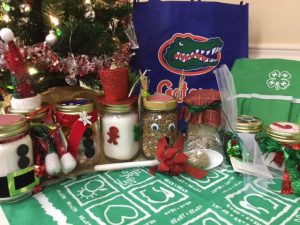
A variety of yummy treats in jars to give as gifts for the holidays.
The Holidays hold some of my fondest memories! Our family would often make special presents for friends and family members. We made things like cookies, candies, breads, and soups that could be shared with others. This can be a fun tradition for your family or 4-H Group to create together!
These gifts usually are not super expensive but can let everyone know you are thinking about them. A lot of times we would make a treat and deliver it along with a container of pre-made mix they could use later to make another serving. That way they know what they are getting and are more likely to make another batch. If this sounds like a fun tradition you may want to incorporate it but remember to be safe while making these special treats. You don’t want to prepare these delights and cause someone to have an allergic reaction or become sick from eating them.
If you like crafting you can decorate bags, jars, spoons, clean ornaments, mugs etc. A bow, ribbon, piece of fabric, dried flowers, sprigs of fresh flowers, holly or pine can make beautiful packages. Remember a little decoration can go a long way and make your gift giving more economical and festive.
Some of our Extension Colleagues from Kentucky KY1 and KY2, Maine, North Dakota and Iowa have some great recipes to share for gifts in a jar, on a spoon or in a mug. Many of these already have premade tags you can download and attach to the item. It also has the individual recipes you can follow and use to make your own special gifts. If you want to make a chocolate cocoa bomb, Maine had the cocoa mix recipe you can use with your molded chocolate! These are definitely yummy treats your friends and family will enjoy!
4-H offers a wide range of volunteer opportunities to fit your interests, skills, and schedule. For more information about Volunteering with 4-H, or to sign up to help youth develop their life skills, please contact your local UF IFAS County Extension Office or visit Florida 4-H Website
by pmdavis | Nov 21, 2023

We love our Military Families!
November is a month many of us celebrate our families and have traditions we enjoy annually. November is also designated as the National Military Family Appreciation Month. For our military families it is a time when the country recognizes the nearly 5.2 million service members and their families. UF/IFAS Extension and 4-H are proud to be a part of the military family working with youth centers across the nation to have some consistency for military kids. 4-H works will military programs worldwide to support our military youth at bases and in local communities. We recognize that our military youth must cope with many circumstances while their parent or sibling is working often away from home. Causing a hole created by the absences during many life events. Military life imposes unique demands on the family, from a change in family structure to the stress of someone missing from events, to the worries of a family member being hurt while working.
Since many of us have a little extra time during the holidays there are several things you can do to show your support of our military members and their families. We as non military families celebrate with each other at family/friend gatherings etc. and sometimes forget that our military friends are away from home and missing these traditions. We can help celebrate, recognize, acknowledge, and show gratitude for those sacrifices our military family’s make so each of us can enjoy freedom by sharing our love.
You can do simple things to demonstrate your appreciation and gratitude for their sacrifice, resiliency, and courage.
Show your support by:

Celebrate our Freedom and express your appreciation to military families!
- Expressing Gratitude and appreciation: You can take a moment to thank military families for their sacrifices and service to the nation. You can send cards, write letters, if you do not know anyone here is a local organization that can help get them to the troops. December 1 is the deadline for Holiday themed cards to go out. You can give shout outs on social media using the hashtag #MilitaryFamilyAppreciation
- Sending care packages to veterans and military families overseas or donate to to Military Support Organizations.
- Giving the gift of time by: visiting a local veteran, spending time with a military family, or volunteering at a veterans organization (contact your local VFW, American Legion, VA hospital or veteran’s shelter).
- If you know a military family, open your doors to share the holidays with you by offering help with tasks like childcare, home maintenance, or meal preparation.
- You can also show your support by participating in community events and initiatives that celebrate and support military families in your area.
I hope you will join Florida 4-H #Florida4H and our Nation #MilitaryFamilyAppreciation to celebrate Military Family Month, by doing simple things to demonstrate your appreciation and gratitude to our military members and their families! Have a wonderful Thanksgiving.

by pmdavis | Sep 14, 2023

First meeting is Sept 26th at 5:30 EST
I am so thrilled to let you know about a new endeavor with Florida 4-H. We are trying a virtual Food Challenge cooking club this year. This is so exciting for me because some of my fondest memories are cooking with my grandmother and Mom. I got to learn how to prepare foods and be creative as I was growing up pulling on their apron strings. I also enjoyed teaching and sharing these skills with my own children. What makes this even better is now I get to share and learn with all of you who join our program.
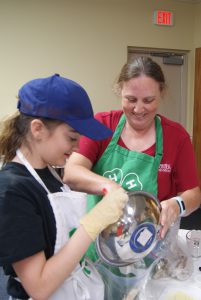
Paula and Madelyn Cooking together
By joining the new Virtual 4-H Food Challenge Club, you will embark on a fun, yet challenging, food-focused adventure right from the comfort of your kitchen! The club adventure will provide a fun atmosphere for you and your children to have a family time experience building lasting memories together. With the help from Florida 4-H Youth Development Faculty, you will get to unleash your culinary creativity and try delicious recipes while learning kitchen skills from safety, nutrition, and other food related life skills. Families will learn about competitive events related to foods like the Florida Food Challenge Competition. Families will also have the opportunity to make friends with fellow 4-H members across the state.
The virtual club is open to youth members ages 8-18 and will meet once a month starting in September. The club will meet via ZOOM on the following Tuesdays: September 26th, October 24th, November 28th, December 19th, and January 23rd from 5:30 – 6:30 PM ET. We request that adult supervision is present with the youth during the meeting and home practice sessions. The participants will be asked to gather a list of supplies for each monthly meeting as we focus on a new skill for each meeting.
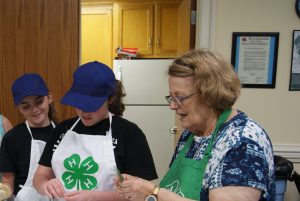
Paula’s family working with herbs to prepare a dish.
During this course we will help families enjoy preparing food, provide you with opportunities to problem solve together and work as a family team as practice preparation for the Florida 4-H Food Challenge! If you join us, your family will learn how to prepare and create yummy dishes with a predetermined set of ingredients. By the end of the program, your family should have some new recipes for your cooking toolbox, learned essential cooking skills and created wonderful memories from your time together. Do not miss this flavorful opportunity – sign up now via Florida 4-H Online and get cooking with 4-H! If you are not a member of a current 4-H Club there is a $20 membership fee associated with this club. If you are unable to join our virtual club, contact your local UF/IFAS Extension office to see if there is an active Food Challenge group that you can join. If not, work with your 4-H or FCS Agent(s) to identify two caring adults who could fill this role.
Enroll, Grab your ingredients, and get ready to join us via Zoom on September 26th@ 5:30 EST
 Who doesn’t love a warm, soft pretzel? Did you know they are fast and easy to make? Pretzels are a yummy way to introduce youth to the science of bread baking. Following a recipe can also help them practice following directions and measuring ingredients. Plus….it’s just fun! In honor of National Pretzel Day, we are sharing our tried and true soft pretzel recipe, which is perfect for your next 4-H club meeting or a fun family night. Of course, be sure to note any youth with food allergies and plan accordingly! This recipe makes 12 pretzels, so you may need to double (or triple) the recipe depending on the number of people you have.
Who doesn’t love a warm, soft pretzel? Did you know they are fast and easy to make? Pretzels are a yummy way to introduce youth to the science of bread baking. Following a recipe can also help them practice following directions and measuring ingredients. Plus….it’s just fun! In honor of National Pretzel Day, we are sharing our tried and true soft pretzel recipe, which is perfect for your next 4-H club meeting or a fun family night. Of course, be sure to note any youth with food allergies and plan accordingly! This recipe makes 12 pretzels, so you may need to double (or triple) the recipe depending on the number of people you have.











